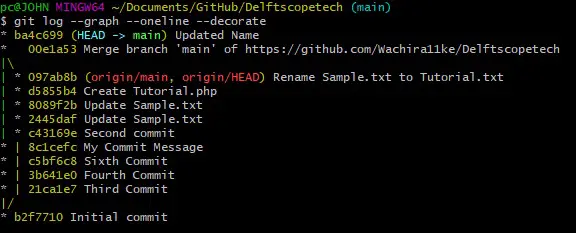Revert a Git repository to a previous commit
This article will discuss various ways to roll back a git repository to a previous commit. You can undo almost anything with Git.
We will look at local and remote repositories, and how to undo unpublished and published commits.
Delete unpublished commits to revert your Git repository to a previous commit
Unpublished commits are simply commits in your local repository that have not yet been pushed to the remote repository. We will explain this concept with an example.
Example 1:
Below is the commit history in our local repository. Note the combination provided for each commit message.

If for some reason we discover that a recent commit had an error, we can remove the commit and revert the repository to its previous state.
In our case, the bad commit should be ba4c699 (update name). We run git rest --hard <sha1-commit-hash>the command to remove this commit.
$ git reset --hard 00e1a53
Output:
HEAD is now at 00e1a53 Merge branch 'main' of https://github.com/Wachira11ke/Delftscopetech
The command above will return your repository to the specified commit and remove the commits after it. The command will also remove all uncommitted changes in your repository.
If you want to keep them and apply them after removing them, run the following command.
$ git stash
$ git reset --hard 00e1a53
$ git stash pop
This combination saves your uncommitted changes and applies them to the new workspace. If you have made modifications to the file, you may encounter merge errors.
Delete published commits to revert your Git repository to a previous commit
Published commits are the changes applied to the remote repository. If we push wrong changes from our local repository to the remote repository, we can revert the repository to a previous version.
It's worth reminding other developers not to fetch from the repository. Let's look at an example.
Example 2:
We have previously discussed how to delete commits in a local repository. Assume that we have already pushed the deleted commits to the remote repository.
In the following context, we can git pushrestore the remote repository using the command.
$ git push --force origin HEAD
The command above will overwrite our remote repository based on the state of our local repository. It will discard any changes made by other developers.
This is a safer option:
$ git push --force-with-lease oriin HEAD
You can specify a branch with the following command:
$ git push -f origin <sha1-commit-hash>:branch_name
Some remote repositories have a receive.denyNonFastForwardsdefault that rejects the command above. In this case, we will have to delete and recreate the branch.
$ git push origin : <branch name>
$ git push origin <sha1-commit-hash>:ref/heads/<branch name>
For reprinting, please send an email to 1244347461@qq.com for approval. After obtaining the author's consent, kindly include the source as a link.
Related Articles
Git installation and establishment of local warehouse service
Publish Date:2025/04/05 Views:89 Category:Git
-
Git is a distributed version control system: the client does not only extract the latest version of the file snapshot, but also completely mirrors the original code repository. It has the following advantages: a. Since every extraction oper
git remote operation——multiple remote repositories for one project
Publish Date:2025/04/05 Views:131 Category:Git
-
Multiple remote repositories for a git project In our git project, the command to operate the remote repository information is $ git remote # 查看当前所有的远程仓库的名称 $ git remote -v # 查看远程仓库的名称和远程仓
Git cherry pick command usage
Publish Date:2025/04/05 Views:190 Category:Git
-
git cherry-pick is a powerful command that allows us to select an arbitrary Git commit by reference and attach it to the HEAD of the current working branch. Cherry picking is the act of picking a commit from one branch and applying it to an
Comparison between Git merge and Git rebase
Publish Date:2025/04/05 Views:171 Category:Git
-
The git rebase command may seem like Git wizardry to beginners, but if used carefully, it can actually make life easier for your development team. In this article, we compare git rebase with the related git merge command and identify all th
How to fix Git error Error: src refspec master does not match any
Publish Date:2025/04/05 Views:124 Category:Git
-
When using Git, we may encounter the error "src refspace master does not match any". Here's what the error means and how to fix it. What does src refspec master does not match any Mean in Git mean? We may encounter this error when we try to
Rebase local branch when pulling changes from remote repository branch in Git
Publish Date:2025/04/05 Views:144 Category:Git
-
This article will cover the basics of rebasing your local branch when pulling changes from a remote repository branch in Git. We use the version control system Git to track changes made to files. We commit changes in a local branch in our l
Undo Git Stash
Publish Date:2025/04/04 Views:187 Category:Git
-
This article explains how to make and save changes to a repository. Git allows you to save changes locally and push them to a server when needed. In Git, we don't use the term save , but commit . We use git add , git commit , and git stash
View a list of cache entries in Git
Publish Date:2025/04/04 Views:59 Category:Git
-
We often need to pause our work and focus on something else in our development environment. Therefore, we may need to temporarily save our current work and focus on a different one. We may want to resume our original work later. git stash T
Git stores specific files
Publish Date:2025/04/04 Views:115 Category:Git
-
This article will cover storing changes to only specific files in Git. In Git, when we make some changes in our working tree, we may have some changes which may or may not be staged in our local repo. We may now wish to save these changes f

